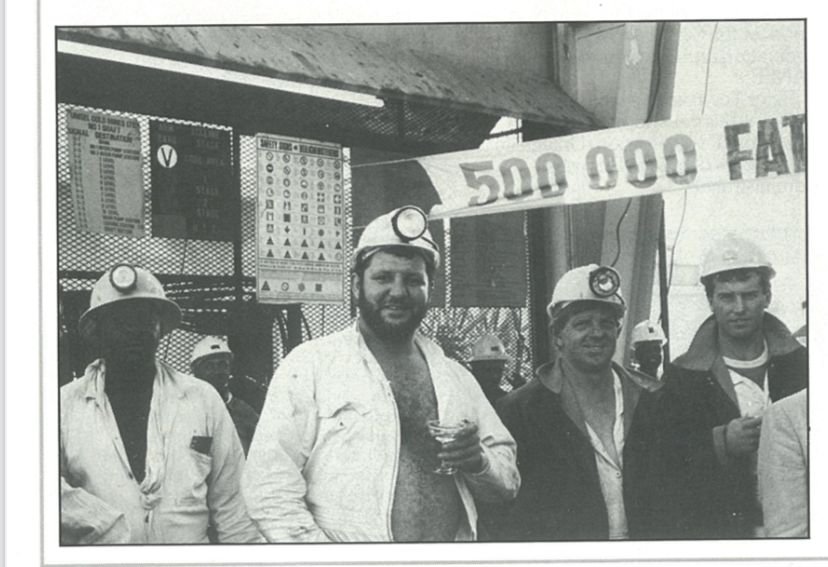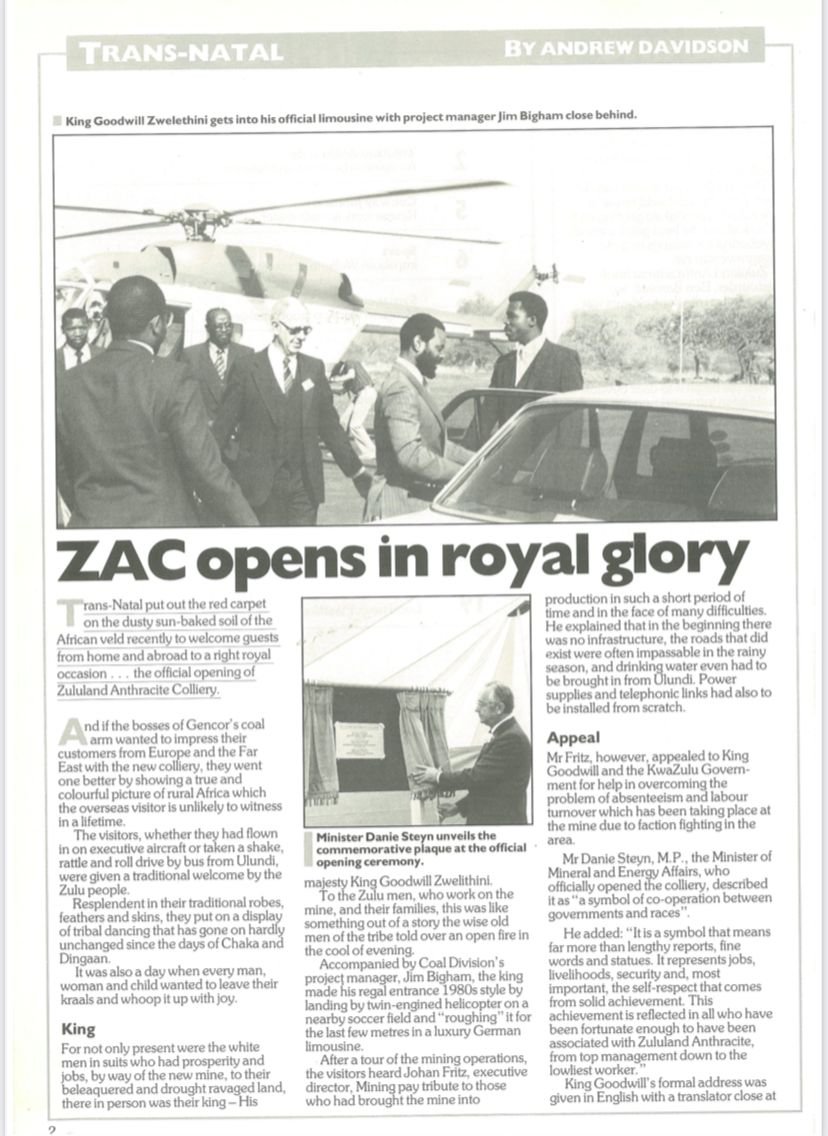Geologist Kevin Petzer
uMnu uKevin Petzer oyiGeologist
Reflecting on ZAC’s past, present and future with one of its founding fathers
Mr Kevin Petzer is a Geologist who was working at mining exploration company Southern Sphere mining in early 1979. He was part of the original* team that investigated the size and economic feasibility of mining the anthracite deposit in the area that would later become Zululand Anthracite Colliery (ZAC). Forty years later he is still a consulting geologist working to extend the current lifespan of the mine.
Mr Petzer in this piece recounts the early days of ZAC and discusses the geological exploratory work he is busy with presently at the mine. When Southern Sphere began exploration work in around 1980, Petzer stayed in a caravan on Kwasheleza Mountain with his wife and child, while the rest of the team set up the camp in the nearby village of Mngeni.
Initially, the team started with field mapping and a very important part of the mapping process was the discovery of the wave ripple marker. He explains that this unit weathers in a very unique fashion which allows for the outcropping to be seen very clearly along with the rock formation, which was about 100 m above the coal horizon.
“This was extremely helpful as we could map it, even though we couldn’t see the coal, but because we found the wave ripple marker, we knew that the anthracite was about 100 m below. This is how the initial drilling programme started and the exploratory work progressed from there,” he recounts.
It didn’t take the campaign very long to find the deposit after that because there were some coal outcrops in the river near where the wash plant is today, as well as near Kwasheleza. The mapping started first and went on for about four or five months, then the drilling started and everything progressed from there. The exploration team numbered around 90 people plus locals who constructed the first roads to ZAC using just pickaxes and shovels.
The exploration work took around four years to complete. Transnatal Coal & Utah Mining JV. Trans Natal wanted to purchase the mine from Southern Sphere and they eventually agreed to an amount, however during the handover period Cyclone Damoina hit KwaZulu-Natal in January 1984.
Damoina Disaster Recalled
Cyclone Domoina – a severe tropical storm - wrought havoc to large swathes of Southern Africa with winds up to 100 km/h and brought torrential rains not seen in over 100 years, which resulted in catastrophic record flooding. Throughout the region, Domoina caused widespread flooding that damaged houses, roads, and crops - leaving about R100 million (around R3.2 billion by today’s value) in damage. There were also tragically over 240 deaths in south-eastern Africa directly resultant from the storm.
Mr Petzer who was not on the site at the time, as he was working on a diamond project in the Western Cape, returned as soon as he could following the news of the storm. It took him four whole days to reach the camp owing to the destruction of roads and flooding of others, on his arrival he discovered the camp had been totally destroyed and members of the team that were managing it had been left injured and hospitalised as a result of the storm.
The camp was re-established a few months after the storm using all the original loggings the team had previously archived. By this time (1985) BHP Billiton (previously known as Transnatal) had taken over the site and began developing the first mine at Okhukho right near where the modern wash plant is today. BHP Billiton also opened two more mines at Mngeni and Kwasheleza. Further, infill drilling was undertaken and the E-block deposit was discovered.
“Originally there was a relatively small block at E-block and further drilling located what’s now called Deep E. Kwasheleza was broadened out which facilitated the discovery of the Western Extension - that has since been mined out - and lastly they drilled again and discovered Ngwabe.”
BHP Billiton had all but written Ngwabe off as a viable deposit to be mined, but Mr Petzer and his colleague Jakes Liebenberg received a small budget, which was just enough to allow them to drill five exploration boreholes. This drilling campaign lead to the discovery of a very large deposit at Ngwabe, which became the mainstay of the mine for many years producing: prime nuts, prime duff and prime peas.
Opening up of new markets drives exploration work
Shortly after Menar acquired ZAC in 2016, it started producing and selling higher ash middling products for the first time, as it only sold prime products previously.
“This brought with it a lot more access to resources and the market opened up for this type of anthracite product. As a result, ZAC revisited Deep E, which had previously not been mined. I also knew from experience of the geology of ZAC that, there was this type of quality anthracite at Mngeni, which could be mined as well,” Mr Petzer remarks.
Mr Petzer’s latest exploration work is focused on delivering this grade of anthracite as part of ZAC’s efforts to increase the existing life of mine. To date, deposits of the required anthracite grades have been found in Mngeni and Okhukho North, he notes.
The exploration work on Mngeni has been completed, while a couple of holes will be drilled in Okhukho North to find an entrance to develop an adi to access the deposit. ZAC also plans to make extensions at Deep E.
Moreover, a series of exploration boreholes have been laid, which are aimed at linking the new Mngeni to the Mngeni North deposit. “We are hoping that structurally and physically there won’t be too many barriers to achieving this,” he states, explaining that this would aid efforts to increase production and extend the life of mine considerably.
At 74 years old, Mr Petzer still finds joy in his job because it helps others find work in a country with a struggling economy and high unemployment.
“I have no intention of retiring any time soon and I look forward to continuing my long relationship with ZAC, along with all the other companies that I am working with throughout the country and the rest of the continent. South Africa has a wealth of mineral resources that need to be utilised in the interest of creating new business and employment opportunities, I am just doing my small part to make this a reality,” Mr Petzer concludes.
*Original Team Responsible for ZAC discovery:
G Taylor (Managing from Head Office)
M Ward (Field Geologist)
G Dowling (Field Geologist)
E Roodt (Field Geologist)
J Turner (Chief Field Geologist)
M Ward (Field Geologist)
P Welman (Field Geologist)
J Liebenberg (Field Geologist)
D Grant (Field Geologist)
J Latilla (Surveyor)
S Bouden (Surveyor)
K Petzer (Field Geologist)
Izolo, inamuhla nekusasa leZAC ngeso lengqqalabutho
UMnuz Kevin Petzer, oyi-geologist, wayesebenzela iSouthern Sphere, inkampani ecwaninga izimayini, ngo-1979. Wayeyingxenye yethimba lokuqala* ukucwaninga ukunotha kwamalahle endaweni okwaholela ekusungulweni kwemayini iZululand Anthracite Colliery (ZAC). Emuva kweminyaka engu-40, usengomunye wama-geologist enza ucwaningo ngenhloso yokwelula ukusebenza kwale mayini.
Lapha uMnuz Petzer usilandisa ngezinsuku zokuqala zeZAC nangomsebenzi amatasa ngawo wokucwaninga emgodini kule mayini. Ngesikhathi iSouthern Sphere iqala umsebenzi wocwaningo ngeminyaka yawo 1980, uPetzer nomkakhe nengane yabo bebehlala kwi-caravan, ngesikhathi ozakwabo behlala ekhempini esigodini esiseduze uMngeni.
Ithimba labacwaningi laqala ngokuhlaziya ibalazwe lendawo kanti okumqoka okwavela kulesi sigaba kwaba ukutholwa kwendawo eseke yathintwa ngamanzi. UPetzer uthi le ndawana yayiwasheke ngendlela engajwayelekile nokwenza kubonakale kahle ukwakheka komhlabathi namatshe kuya kuma-meter angu-100 ngaphansi komhlaba.
“Lokhu kwasisiza kakhulu ukuhlonza itshe lelahle ngaphansi komhlaba. Yize sasingakakwazi ukulibona ngeso, kodwa ngoba sathola le ndawana eyagujwa ngamanzi, sakwazi ukuthola ukuthi ilahle lisemamitheni angu-100 ngaphansi komhlaba. Yilapho kwaqala khona uhlelo lokumba ukuze kuqhutshekwe nocwaningo,” kusho uPetzer.
Emuva kwalokho akuthathanga sikhathi singakanani ukufinyelela emalahleni ngoba ayevela naseduze komfula, la namuhla kukhona isikhungo sokuwageza amalahle, naseduze kwakwaSheleza. Ukuhlaziywa kwebalazwe kwaqhutshwa izinyanga ezine kuya kwezinhlanu ngaphambi kokuqaliswa kokumbiwa, okunye kwavela emuva kwalokho. Ithimba labacwaningi lalinabantu abalinganiselwa ku-90, okubalwa kubo namalungu omphakathi akha imigwaqo yokuqala eya eZAC isebenzisa amapiki namafosholo.
Umsebenzi wokucwaninga waqhutshwa iminyaka ecela kwemine. Inkampani iTransnatal Coal & Utah Mining JV yafuna ukuthenga imayini kwuSouthern Sphere, kwavunyelwana nangezimali. Kuthe ngoJanuwari ka-1984, ngesikhathi sekwenziwa uhlelo lokudluliswa kokunini ngokusemthwethweni, kwahlasela isishingishane uDamoina kwaZulu-Natal.
Isibhicingo sesivunguvungu uDamoina
iCyclone Damoina – isishingishane esinamandla – sashiya kukhalwa ezindaweni eziseningizimu ye-Africa. Umoya wawulinganiselwa ku-100km/h wawuhambisana nezimvula ezinamandla ezazingakaze zibonwe eminyakeni ewu-100, nokwaholela ezikhukhuleni ezacekela phansi izindlu, imigwaqo nezitshalo. Umonakalo wawulinganiselwa ku-R100 million (cishe uR3.2 billion ngokwenani lamanje). Kwashona abantu abangaphezulu kuka-120 kulesi sibhicongo eningizimu-mpumalanga ye-Africa.
UMnuz Petzer, owayengekho emayini ngaleso sikhathi, waphuthuma wabuya emuva kokuzwa izindaba zalesi sishingishane. Ngenxa yomonakalo emgwaqweni nezikhukhula, kwamthatha izinsuku ezine ukufinyelela ekhempini. Wafika wathola ukuthi ikhempu yayikhahlamezekile kwathi abebekuyo balimala kanzima, abanye bangeniswa ezibhedlela ngenxa yalesi sishingishane.
Ikhempu yavuselelwa emuva kwezinyanga ezimbalwa emuva kweshishingishane kusetshenziswa izingodo ezaziqoqwe ngabasebenzi. Ngaleso sikhathi (ngo-1985) iBHP Billiton (eyayaziwa ngeTransnatal) yiyo eyayisithathe izintambo yaqalisa ukusungulwa kwemayini yokuqala Okhukho, eduze kwalapho kukhona izikhungo zokuhlamba amalahle namuhla. I-BHP Billiton yavula ezinye izimayini ezimbili eMngeni naKwaSheleza. Kwaqhubeka ukumba nokugcwalisa kwaze kwatholakala amalahle ku-E-block.
Ekuqaleni kwakukhona itshe elincane ku-E-block, kwathi ngokuqhubeka kokumbiwa kwatholakala amanye engxenyeni manje esiyaziwa ngeDeep E. Imayini eKwasheleza yanwetshwa, okwaholela ekutholakaleni kwe-Western Extension – engasenamalahle manje. Kwambiwa futhi kwatholakala amanye eNgwabe.”
IBHP Billiton yayisiphonse ithawula ngokuthi kungaba khona amalahle eNgwabe kodwa uMnuz Petzer nozakwabo uMnuz Jakes Liebenberg bathola ibhajethi encane, kodwa bakwazi ukumba izimbono ezinhlanu benza ucwaningo. Umkhankaso wokumba waholela ekutholweni kwengqumba yamalahle eNgwabe, nalapho kugcine sekuyisizinda semayini iminyaka eminingi kukhiqizwa izinhlobo zamalahle i-prime nut, i-prime duff ne-prime peas.
Ukuvulwa kwezimakethe ezintsha kuchumisa umsebenzi wokucwaninga
Emuva nje kokuthi iMenar ithathe izintambo eZAC, lemayini yaqala ukukhiqiza imikhiqizo yamalahle egayiwe, njengoba ngaphambi kwalokho yayikhiqhiza eyitshe kuphela.
“Lokhu kwenza ukuthi zitholakale kalula izinsiza kanti nezimakethe zaqala ukuyemukela le mikhiqizo yamalahle. Ngenxa yalokho, iZAC yabuyela eDeep E, eyayikade ingambiwanga. Ngangazi ngokwamava ami ngicwaninga umhlaba weZAC ukuthi kwakukhona la malahle eMngeni, angambiwa uma kudingeka,” kuchaza uMnuz Petzer.
Uthe umsebenzi wakhe wakamuva ugxile ekutholeni lolu hlobo lwamalahle njengengxenye yemizamo yeZAC ukulula ukusebenza kwemayini. Uthe kuze kube yimanje sekutholakele i-anthracite efanele eMngeni nasoKhukho.
Ngaphezu kwalokho sekumbiwe imigodi yokucwaninga ngenhloso yokuhlanganisa ingxenye enamalahle eseMngeni nengxenye eseNyakatho noMngeni. “Siyethemba ukuthi ngokwengqalasizinda nangokwesimo sendawo azizukuba ningi izihibe emizamweni yokuzuza lokhu,” usho kanje, egcizelela ukuthi lokhu kuzosiza emizamweni yokwenyusa inani lomkhiqizo nokwelula ukusebenza kwemayini.
Yize eseneminyaka engu-74, uPetzer usawujabulela umsebenzi awenzayo ngoba usiza abanye abantu bathole itoho ezweni elinomnotho odonsa kanzima nenani eliphezulu labantu abangasebenzi.
“Angiziboni ngithatha umhlalaphansi esikhathini esiseduze futhi ngilangazelele ukuqhubeka nobudlelwano bami beminyaka neZAC, nazo zonke izinkampani engisebenzisana nazo ezweni, nakwizwekazi lonkana,” kuphetha u Petzer.
*Ithimba lokuqala elaholela ekusungulweni kweZAC:
G Taylor (Managing from Head Office)
M Ward (Field Geologist)
G Dowling (Field Geologist)
E Roodt (Field Geologist)
J Turner (Chief Field Geologist)
M Ward (Field Geologist)
P Welman (Field Geologist)
J Liebenberg (Field Geologist)
D Grant (Field Geologist)
J Latilla (Surveyor)
S Bouden (Surveyor)
K Petzer (Field Geologist)
ZAC Historical Images
Izithombe zomlando weZAC
ZAC’s first logo
Uphawu lokuqala lwe ZAC









